NURSING ASSIGNMENT.
VerifiedAdded on 2022/11/13
|8
|1897
|4
AI Summary
Contribute Materials
Your contribution can guide someone’s learning journey. Share your
documents today.

0NURSING ASSIGNMENT
NURSING ASSIGNMENT
Student name:
Student number:
HLSC122 Semester 1, 2019
Assessment 3: Critical appraisal of evidence
Word count:
Student name/student number
NURSING ASSIGNMENT
Student name:
Student number:
HLSC122 Semester 1, 2019
Assessment 3: Critical appraisal of evidence
Word count:
Student name/student number
Secure Best Marks with AI Grader
Need help grading? Try our AI Grader for instant feedback on your assignments.

1NURSING ASSIGNMENT
Full reference
Day, N., Criss, J., Griffiths, B., Gujral, S. K., John-Leader, F., Johnston, J., & Pit, S. (2018).
Music festival attendees’ illicit drug use, knowledge and practices regarding drug content
and purity: a cross-sectional survey. Harm reduction journal, 15(1), 1.
Introduction
The essay will focus on the concept of critical appraisal of a research article that revolves
around the concept of drug checking of youth at festival and highlighting their behavior and
attitude towards consumption of illicit drug. Critical appraisal is defined as the method of
systematically and carefully evaluating the result of evidence-based research in order to compare
its value, relevance and trustworthiness related to the matter of context (Marcus, 2018). This
essay consist of two part, where first part will highlight the strength and limitation of the
research article by critically appraising the article including aim, research design, research
methodology, results and limitation of the study (Day et al., 2018). The second part will
highlight the application of the research evidence based on the case study of Emily, who was
going to attend a music festival in Melbourne.
PART A – Critical appraisal
Authorship
Authorship basically defines the specialty, origin and affiliation of the authors or
contributors who are responsible for writing the academic research articles and highlighting the
key facts of the research (Kamuf, 2018). It is also defined as the method of giving credit to the
authors who have participated and contributed towards the research and thus the researcher
Student name/student number
Full reference
Day, N., Criss, J., Griffiths, B., Gujral, S. K., John-Leader, F., Johnston, J., & Pit, S. (2018).
Music festival attendees’ illicit drug use, knowledge and practices regarding drug content
and purity: a cross-sectional survey. Harm reduction journal, 15(1), 1.
Introduction
The essay will focus on the concept of critical appraisal of a research article that revolves
around the concept of drug checking of youth at festival and highlighting their behavior and
attitude towards consumption of illicit drug. Critical appraisal is defined as the method of
systematically and carefully evaluating the result of evidence-based research in order to compare
its value, relevance and trustworthiness related to the matter of context (Marcus, 2018). This
essay consist of two part, where first part will highlight the strength and limitation of the
research article by critically appraising the article including aim, research design, research
methodology, results and limitation of the study (Day et al., 2018). The second part will
highlight the application of the research evidence based on the case study of Emily, who was
going to attend a music festival in Melbourne.
PART A – Critical appraisal
Authorship
Authorship basically defines the specialty, origin and affiliation of the authors or
contributors who are responsible for writing the academic research articles and highlighting the
key facts of the research (Kamuf, 2018). It is also defined as the method of giving credit to the
authors who have participated and contributed towards the research and thus the researcher
Student name/student number
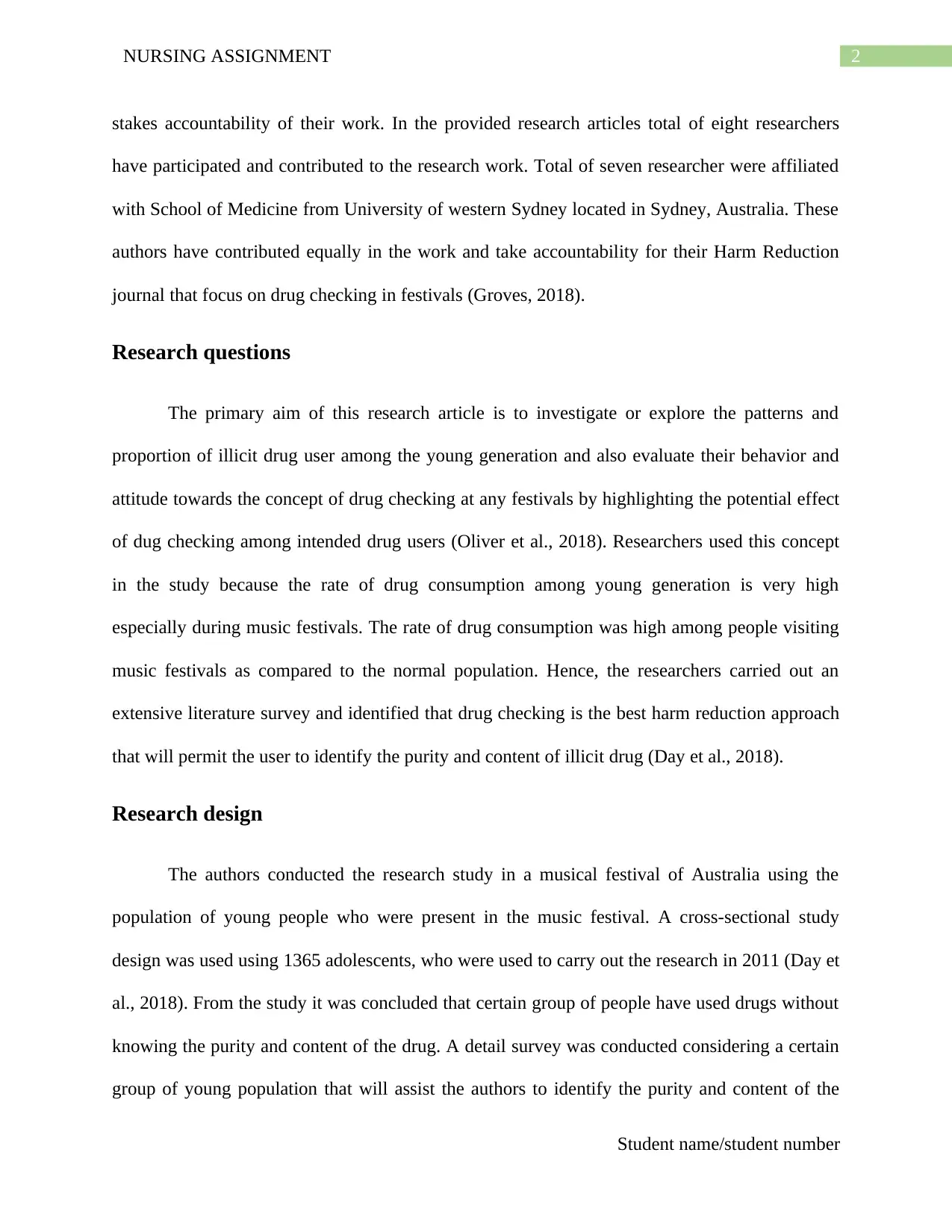
2NURSING ASSIGNMENT
stakes accountability of their work. In the provided research articles total of eight researchers
have participated and contributed to the research work. Total of seven researcher were affiliated
with School of Medicine from University of western Sydney located in Sydney, Australia. These
authors have contributed equally in the work and take accountability for their Harm Reduction
journal that focus on drug checking in festivals (Groves, 2018).
Research questions
The primary aim of this research article is to investigate or explore the patterns and
proportion of illicit drug user among the young generation and also evaluate their behavior and
attitude towards the concept of drug checking at any festivals by highlighting the potential effect
of dug checking among intended drug users (Oliver et al., 2018). Researchers used this concept
in the study because the rate of drug consumption among young generation is very high
especially during music festivals. The rate of drug consumption was high among people visiting
music festivals as compared to the normal population. Hence, the researchers carried out an
extensive literature survey and identified that drug checking is the best harm reduction approach
that will permit the user to identify the purity and content of illicit drug (Day et al., 2018).
Research design
The authors conducted the research study in a musical festival of Australia using the
population of young people who were present in the music festival. A cross-sectional study
design was used using 1365 adolescents, who were used to carry out the research in 2011 (Day et
al., 2018). From the study it was concluded that certain group of people have used drugs without
knowing the purity and content of the drug. A detail survey was conducted considering a certain
group of young population that will assist the authors to identify the purity and content of the
Student name/student number
stakes accountability of their work. In the provided research articles total of eight researchers
have participated and contributed to the research work. Total of seven researcher were affiliated
with School of Medicine from University of western Sydney located in Sydney, Australia. These
authors have contributed equally in the work and take accountability for their Harm Reduction
journal that focus on drug checking in festivals (Groves, 2018).
Research questions
The primary aim of this research article is to investigate or explore the patterns and
proportion of illicit drug user among the young generation and also evaluate their behavior and
attitude towards the concept of drug checking at any festivals by highlighting the potential effect
of dug checking among intended drug users (Oliver et al., 2018). Researchers used this concept
in the study because the rate of drug consumption among young generation is very high
especially during music festivals. The rate of drug consumption was high among people visiting
music festivals as compared to the normal population. Hence, the researchers carried out an
extensive literature survey and identified that drug checking is the best harm reduction approach
that will permit the user to identify the purity and content of illicit drug (Day et al., 2018).
Research design
The authors conducted the research study in a musical festival of Australia using the
population of young people who were present in the music festival. A cross-sectional study
design was used using 1365 adolescents, who were used to carry out the research in 2011 (Day et
al., 2018). From the study it was concluded that certain group of people have used drugs without
knowing the purity and content of the drug. A detail survey was conducted considering a certain
group of young population that will assist the authors to identify the purity and content of the
Student name/student number
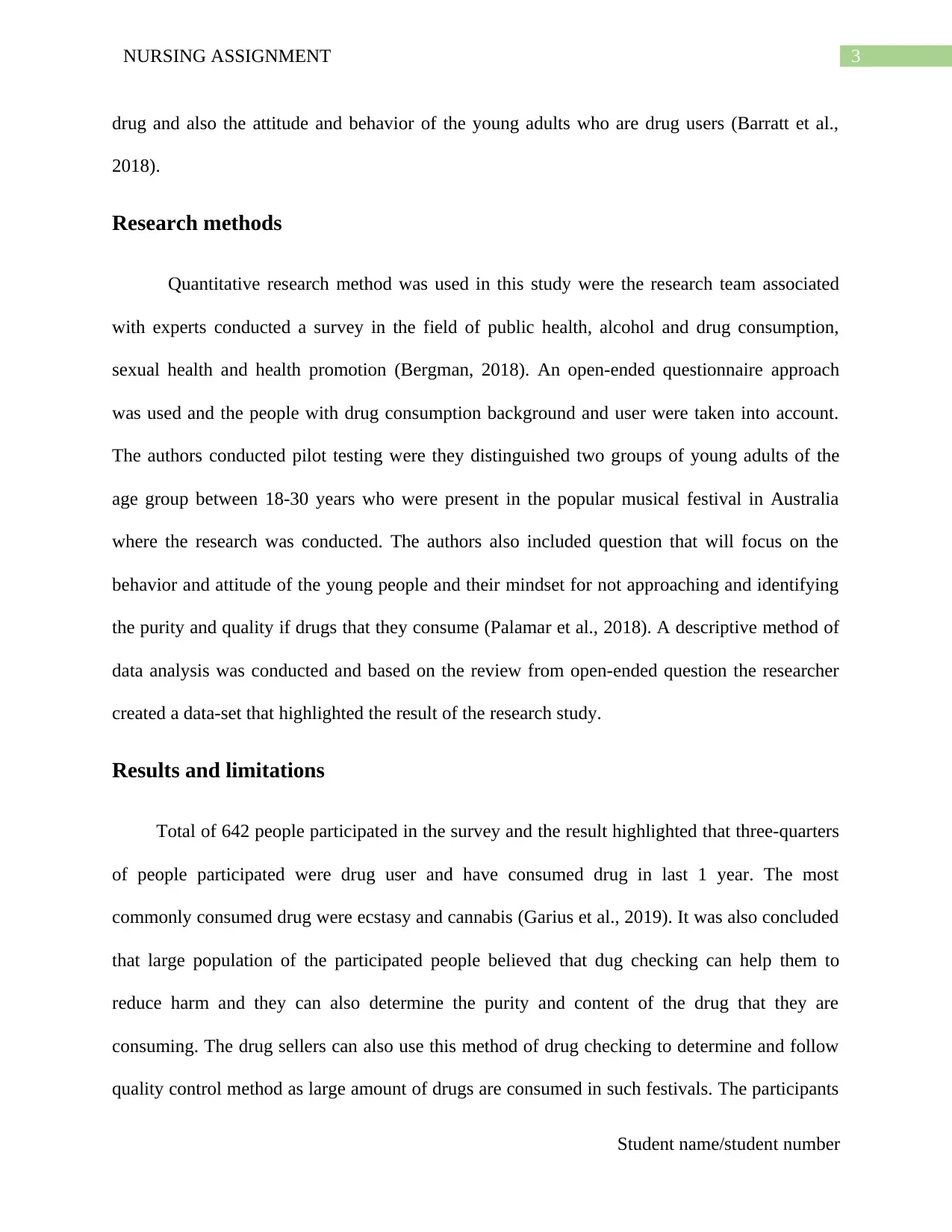
3NURSING ASSIGNMENT
drug and also the attitude and behavior of the young adults who are drug users (Barratt et al.,
2018).
Research methods
Quantitative research method was used in this study were the research team associated
with experts conducted a survey in the field of public health, alcohol and drug consumption,
sexual health and health promotion (Bergman, 2018). An open-ended questionnaire approach
was used and the people with drug consumption background and user were taken into account.
The authors conducted pilot testing were they distinguished two groups of young adults of the
age group between 18-30 years who were present in the popular musical festival in Australia
where the research was conducted. The authors also included question that will focus on the
behavior and attitude of the young people and their mindset for not approaching and identifying
the purity and quality if drugs that they consume (Palamar et al., 2018). A descriptive method of
data analysis was conducted and based on the review from open-ended question the researcher
created a data-set that highlighted the result of the research study.
Results and limitations
Total of 642 people participated in the survey and the result highlighted that three-quarters
of people participated were drug user and have consumed drug in last 1 year. The most
commonly consumed drug were ecstasy and cannabis (Garius et al., 2019). It was also concluded
that large population of the participated people believed that dug checking can help them to
reduce harm and they can also determine the purity and content of the drug that they are
consuming. The drug sellers can also use this method of drug checking to determine and follow
quality control method as large amount of drugs are consumed in such festivals. The participants
Student name/student number
drug and also the attitude and behavior of the young adults who are drug users (Barratt et al.,
2018).
Research methods
Quantitative research method was used in this study were the research team associated
with experts conducted a survey in the field of public health, alcohol and drug consumption,
sexual health and health promotion (Bergman, 2018). An open-ended questionnaire approach
was used and the people with drug consumption background and user were taken into account.
The authors conducted pilot testing were they distinguished two groups of young adults of the
age group between 18-30 years who were present in the popular musical festival in Australia
where the research was conducted. The authors also included question that will focus on the
behavior and attitude of the young people and their mindset for not approaching and identifying
the purity and quality if drugs that they consume (Palamar et al., 2018). A descriptive method of
data analysis was conducted and based on the review from open-ended question the researcher
created a data-set that highlighted the result of the research study.
Results and limitations
Total of 642 people participated in the survey and the result highlighted that three-quarters
of people participated were drug user and have consumed drug in last 1 year. The most
commonly consumed drug were ecstasy and cannabis (Garius et al., 2019). It was also concluded
that large population of the participated people believed that dug checking can help them to
reduce harm and they can also determine the purity and content of the drug that they are
consuming. The drug sellers can also use this method of drug checking to determine and follow
quality control method as large amount of drugs are consumed in such festivals. The participants
Student name/student number
Secure Best Marks with AI Grader
Need help grading? Try our AI Grader for instant feedback on your assignments.
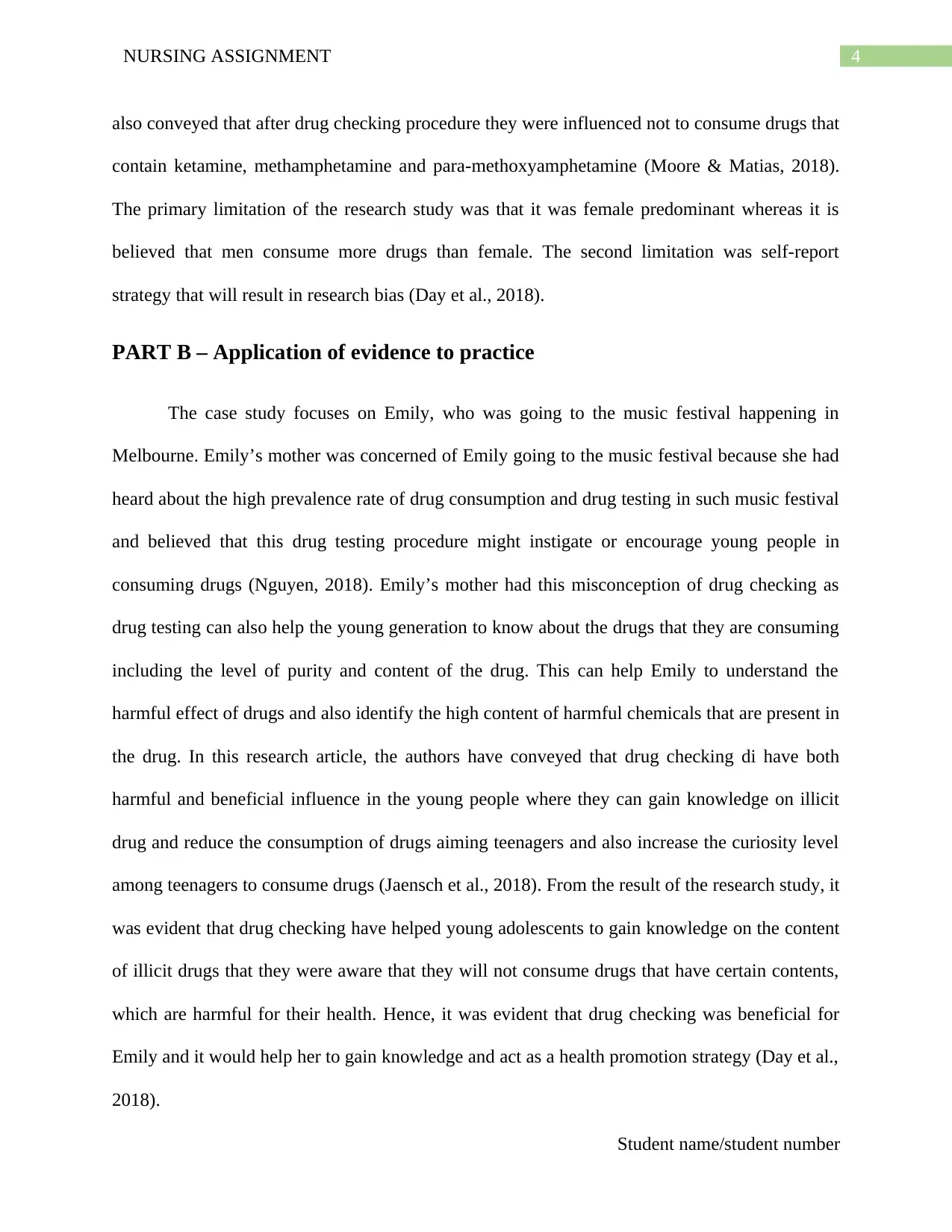
4NURSING ASSIGNMENT
also conveyed that after drug checking procedure they were influenced not to consume drugs that
contain ketamine, methamphetamine and para-methoxyamphetamine (Moore & Matias, 2018).
The primary limitation of the research study was that it was female predominant whereas it is
believed that men consume more drugs than female. The second limitation was self-report
strategy that will result in research bias (Day et al., 2018).
PART B – Application of evidence to practice
The case study focuses on Emily, who was going to the music festival happening in
Melbourne. Emily’s mother was concerned of Emily going to the music festival because she had
heard about the high prevalence rate of drug consumption and drug testing in such music festival
and believed that this drug testing procedure might instigate or encourage young people in
consuming drugs (Nguyen, 2018). Emily’s mother had this misconception of drug checking as
drug testing can also help the young generation to know about the drugs that they are consuming
including the level of purity and content of the drug. This can help Emily to understand the
harmful effect of drugs and also identify the high content of harmful chemicals that are present in
the drug. In this research article, the authors have conveyed that drug checking di have both
harmful and beneficial influence in the young people where they can gain knowledge on illicit
drug and reduce the consumption of drugs aiming teenagers and also increase the curiosity level
among teenagers to consume drugs (Jaensch et al., 2018). From the result of the research study, it
was evident that drug checking have helped young adolescents to gain knowledge on the content
of illicit drugs that they were aware that they will not consume drugs that have certain contents,
which are harmful for their health. Hence, it was evident that drug checking was beneficial for
Emily and it would help her to gain knowledge and act as a health promotion strategy (Day et al.,
2018).
Student name/student number
also conveyed that after drug checking procedure they were influenced not to consume drugs that
contain ketamine, methamphetamine and para-methoxyamphetamine (Moore & Matias, 2018).
The primary limitation of the research study was that it was female predominant whereas it is
believed that men consume more drugs than female. The second limitation was self-report
strategy that will result in research bias (Day et al., 2018).
PART B – Application of evidence to practice
The case study focuses on Emily, who was going to the music festival happening in
Melbourne. Emily’s mother was concerned of Emily going to the music festival because she had
heard about the high prevalence rate of drug consumption and drug testing in such music festival
and believed that this drug testing procedure might instigate or encourage young people in
consuming drugs (Nguyen, 2018). Emily’s mother had this misconception of drug checking as
drug testing can also help the young generation to know about the drugs that they are consuming
including the level of purity and content of the drug. This can help Emily to understand the
harmful effect of drugs and also identify the high content of harmful chemicals that are present in
the drug. In this research article, the authors have conveyed that drug checking di have both
harmful and beneficial influence in the young people where they can gain knowledge on illicit
drug and reduce the consumption of drugs aiming teenagers and also increase the curiosity level
among teenagers to consume drugs (Jaensch et al., 2018). From the result of the research study, it
was evident that drug checking have helped young adolescents to gain knowledge on the content
of illicit drugs that they were aware that they will not consume drugs that have certain contents,
which are harmful for their health. Hence, it was evident that drug checking was beneficial for
Emily and it would help her to gain knowledge and act as a health promotion strategy (Day et al.,
2018).
Student name/student number
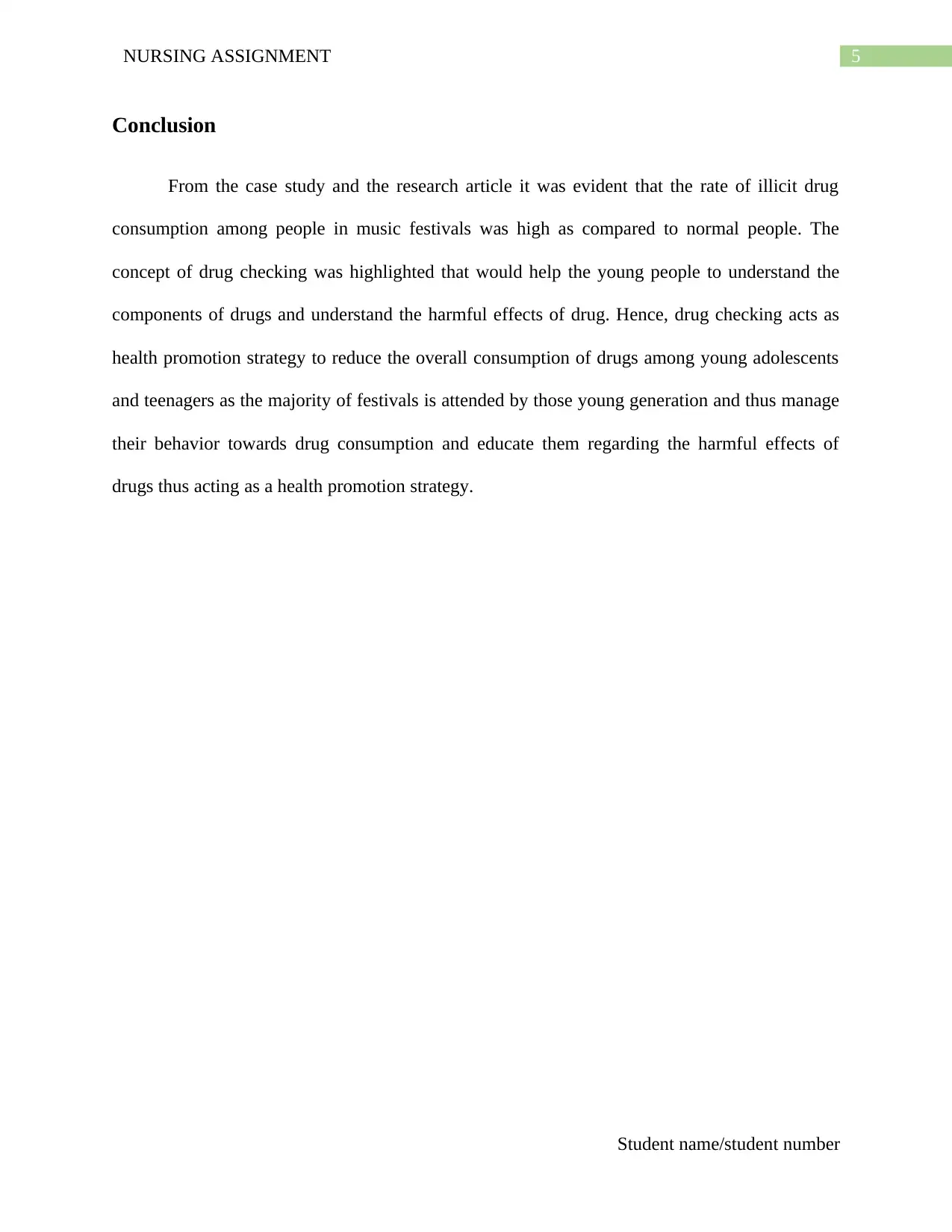
5NURSING ASSIGNMENT
Conclusion
From the case study and the research article it was evident that the rate of illicit drug
consumption among people in music festivals was high as compared to normal people. The
concept of drug checking was highlighted that would help the young people to understand the
components of drugs and understand the harmful effects of drug. Hence, drug checking acts as
health promotion strategy to reduce the overall consumption of drugs among young adolescents
and teenagers as the majority of festivals is attended by those young generation and thus manage
their behavior towards drug consumption and educate them regarding the harmful effects of
drugs thus acting as a health promotion strategy.
Student name/student number
Conclusion
From the case study and the research article it was evident that the rate of illicit drug
consumption among people in music festivals was high as compared to normal people. The
concept of drug checking was highlighted that would help the young people to understand the
components of drugs and understand the harmful effects of drug. Hence, drug checking acts as
health promotion strategy to reduce the overall consumption of drugs among young adolescents
and teenagers as the majority of festivals is attended by those young generation and thus manage
their behavior towards drug consumption and educate them regarding the harmful effects of
drugs thus acting as a health promotion strategy.
Student name/student number
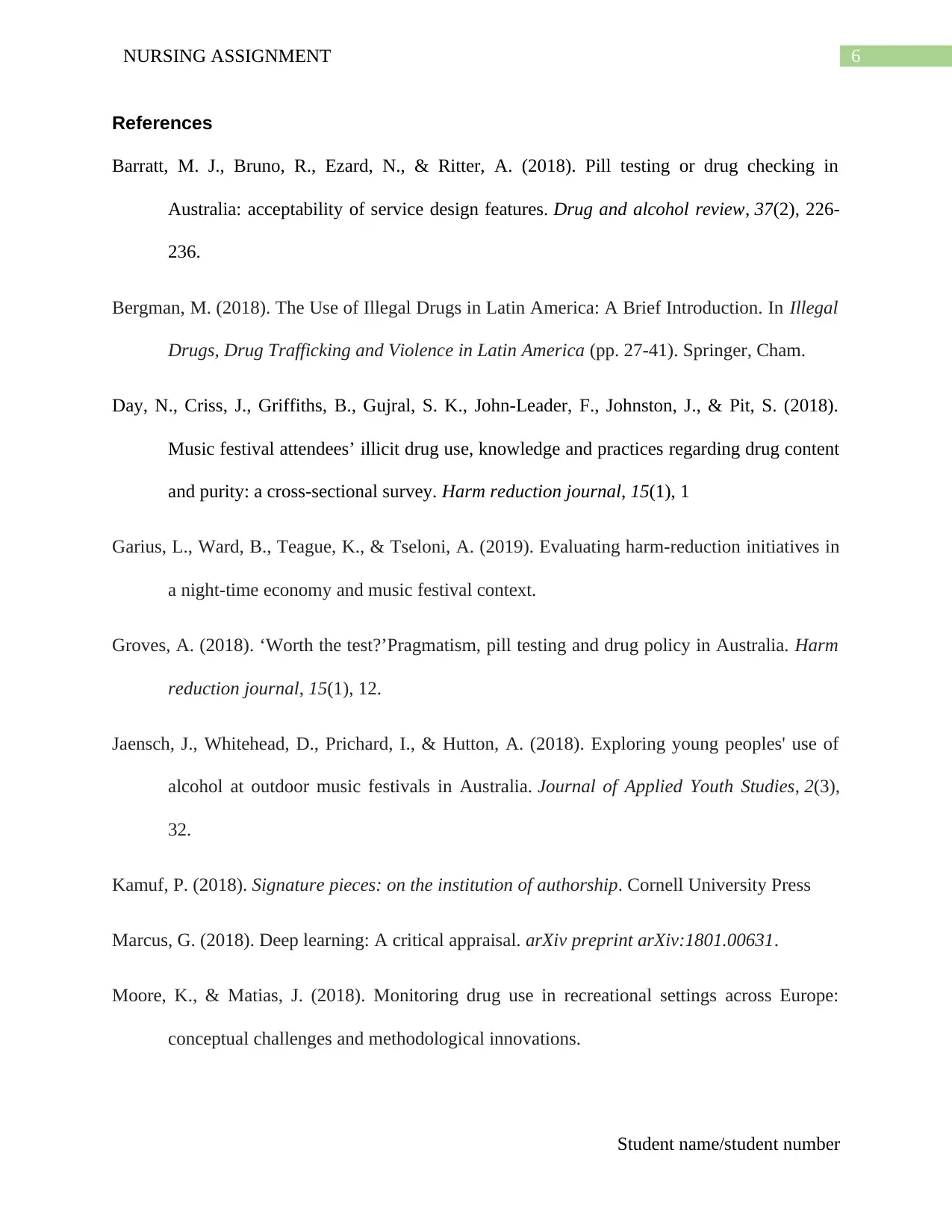
6NURSING ASSIGNMENT
References
Barratt, M. J., Bruno, R., Ezard, N., & Ritter, A. (2018). Pill testing or drug checking in
Australia: acceptability of service design features. Drug and alcohol review, 37(2), 226-
236.
Bergman, M. (2018). The Use of Illegal Drugs in Latin America: A Brief Introduction. In Illegal
Drugs, Drug Trafficking and Violence in Latin America (pp. 27-41). Springer, Cham.
Day, N., Criss, J., Griffiths, B., Gujral, S. K., John-Leader, F., Johnston, J., & Pit, S. (2018).
Music festival attendees’ illicit drug use, knowledge and practices regarding drug content
and purity: a cross-sectional survey. Harm reduction journal, 15(1), 1
Garius, L., Ward, B., Teague, K., & Tseloni, A. (2019). Evaluating harm-reduction initiatives in
a night-time economy and music festival context.
Groves, A. (2018). ‘Worth the test?’Pragmatism, pill testing and drug policy in Australia. Harm
reduction journal, 15(1), 12.
Jaensch, J., Whitehead, D., Prichard, I., & Hutton, A. (2018). Exploring young peoples' use of
alcohol at outdoor music festivals in Australia. Journal of Applied Youth Studies, 2(3),
32.
Kamuf, P. (2018). Signature pieces: on the institution of authorship. Cornell University Press
Marcus, G. (2018). Deep learning: A critical appraisal. arXiv preprint arXiv:1801.00631.
Moore, K., & Matias, J. (2018). Monitoring drug use in recreational settings across Europe:
conceptual challenges and methodological innovations.
Student name/student number
References
Barratt, M. J., Bruno, R., Ezard, N., & Ritter, A. (2018). Pill testing or drug checking in
Australia: acceptability of service design features. Drug and alcohol review, 37(2), 226-
236.
Bergman, M. (2018). The Use of Illegal Drugs in Latin America: A Brief Introduction. In Illegal
Drugs, Drug Trafficking and Violence in Latin America (pp. 27-41). Springer, Cham.
Day, N., Criss, J., Griffiths, B., Gujral, S. K., John-Leader, F., Johnston, J., & Pit, S. (2018).
Music festival attendees’ illicit drug use, knowledge and practices regarding drug content
and purity: a cross-sectional survey. Harm reduction journal, 15(1), 1
Garius, L., Ward, B., Teague, K., & Tseloni, A. (2019). Evaluating harm-reduction initiatives in
a night-time economy and music festival context.
Groves, A. (2018). ‘Worth the test?’Pragmatism, pill testing and drug policy in Australia. Harm
reduction journal, 15(1), 12.
Jaensch, J., Whitehead, D., Prichard, I., & Hutton, A. (2018). Exploring young peoples' use of
alcohol at outdoor music festivals in Australia. Journal of Applied Youth Studies, 2(3),
32.
Kamuf, P. (2018). Signature pieces: on the institution of authorship. Cornell University Press
Marcus, G. (2018). Deep learning: A critical appraisal. arXiv preprint arXiv:1801.00631.
Moore, K., & Matias, J. (2018). Monitoring drug use in recreational settings across Europe:
conceptual challenges and methodological innovations.
Student name/student number
Paraphrase This Document
Need a fresh take? Get an instant paraphrase of this document with our AI Paraphraser
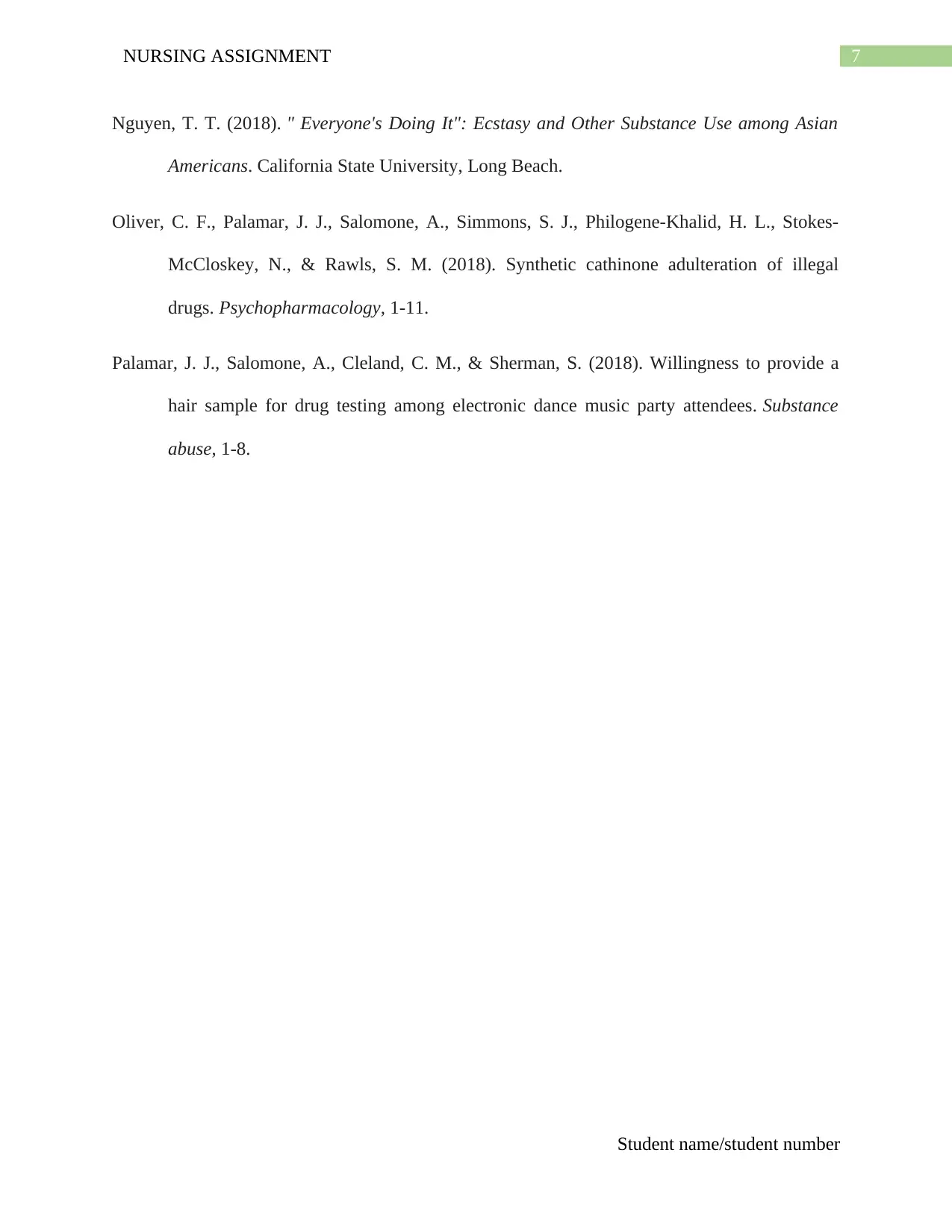
7NURSING ASSIGNMENT
Nguyen, T. T. (2018). " Everyone's Doing It": Ecstasy and Other Substance Use among Asian
Americans. California State University, Long Beach.
Oliver, C. F., Palamar, J. J., Salomone, A., Simmons, S. J., Philogene-Khalid, H. L., Stokes-
McCloskey, N., & Rawls, S. M. (2018). Synthetic cathinone adulteration of illegal
drugs. Psychopharmacology, 1-11.
Palamar, J. J., Salomone, A., Cleland, C. M., & Sherman, S. (2018). Willingness to provide a
hair sample for drug testing among electronic dance music party attendees. Substance
abuse, 1-8.
Student name/student number
Nguyen, T. T. (2018). " Everyone's Doing It": Ecstasy and Other Substance Use among Asian
Americans. California State University, Long Beach.
Oliver, C. F., Palamar, J. J., Salomone, A., Simmons, S. J., Philogene-Khalid, H. L., Stokes-
McCloskey, N., & Rawls, S. M. (2018). Synthetic cathinone adulteration of illegal
drugs. Psychopharmacology, 1-11.
Palamar, J. J., Salomone, A., Cleland, C. M., & Sherman, S. (2018). Willingness to provide a
hair sample for drug testing among electronic dance music party attendees. Substance
abuse, 1-8.
Student name/student number
1 out of 8
Your All-in-One AI-Powered Toolkit for Academic Success.
+13062052269
info@desklib.com
Available 24*7 on WhatsApp / Email
![[object Object]](/_next/static/media/star-bottom.7253800d.svg)
Unlock your academic potential
© 2024 | Zucol Services PVT LTD | All rights reserved.





